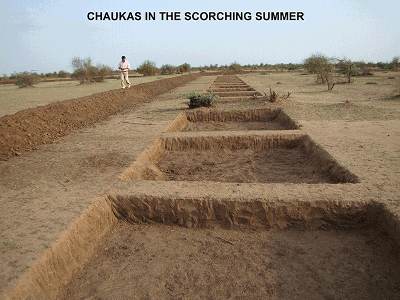This Rajasthan village has kept drought away for thirty years. It can happen all over the country.

Long queues for government-supplied water tankers are a common summer sight in most parts of Rajasthan. But in Laporiya, a village 80 km from Jaipur, a collective effort to harvest water by 350 families has been defying drought for the past 30 years. While ground water has gone down to 500 feet in nearby areas, it is found at 15-40 feet in this village. Not only does lush Laporiya have enough water for its population of nearly 2,000, it even supplies water to some 10-15 surrounding villages.
This journey from scarcity to self-sufficiency started in 1977 when an 18-year-old Laxman Singh returned to his village only to find that it gripped by poverty, caste conflicts and malnourishment. The school dropout realized that the only way to stop this vicious cycle of misfortune was to make the area agriculturally prosperous. But water was a big problem — it was available at a depth of 100 feet. “Back then, there were hardly any means to pump out water at such a depth. I decided that if we cannot go down, the water has to come up,” said Singh. He then devised the chowka system based on a traditional method of water harvesting in Rajasthan and founded the non-profit organization Gram Vikas Navyuvak Mandal Laporiya (GVNML).

Under the chowka system, small, interconnected, sloping rectangular pits, nine inches deep, are made in pasture land. The pits are bordered with bunds (mud embankment). As water assembles in one chowka it flows into an adjacent chowka and then spreads evenly because of the bunds. After crossing several such chowkas, water finally moves into a pond. This method of preserving rainwater makes the top layer of soil moist, recharges ground water, and also enables growth of native grasses and shrubs.
Over 15 years, the chowka system was developed on about 400 bighas of pasture land. The villagers came together and contributed money and labour to make the bunds. With the soil gaining moisture, villagers were able to harvest their crop without irrigating their fields. As there is no withdrawal of ground water for the winter crop, it gets recharged and is used during summers.
There’s been some smart crop planning too. Villagers stay away from water-intensive crops. During summer, cultivation of only green fodder and vegetables is allowed and that too in fields that are close to the well.
The discipline reaped some additional benefits. As the pasture land got green, animals started getting enough fodder. An indigenous breed of cow (Gir) was brought from Gujarat and dairy farming was promoted. Gir produces 8-10 litres of milk in a day and each house now has at least two of them. “Each household makes about Rs 30,000 — 45,000 a month by selling milk. It’s more for those who have over five cows,” said Arjun Singh, a volunteer of GVNML. The example has now been followed by 58 neighboring villages and is now spreading to other districts.
So, by adopting the traditional water harvesting system and staying away from water-intensive crops, the villagers have acquired the most precious wealth on the planet – water. The collective efforts of entire village made the self reliable sources of water, hope this term is adopted by entire country and no one faces water shortage in scorching heat conditions

 Currency Convertor
Currency Convertor Post an article
Post an article Covid19 Updates
Covid19 Updates Elive Today.
Elive Today.

 sending...
sending...




